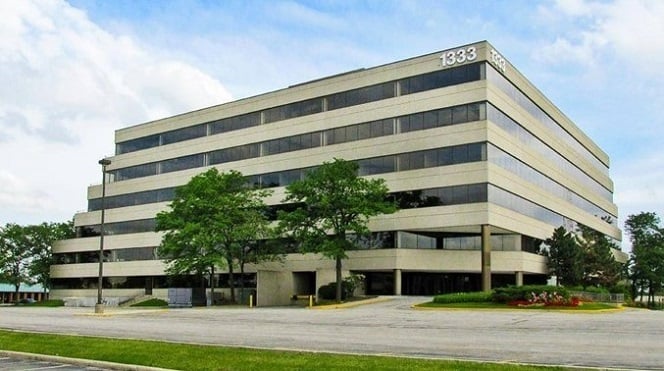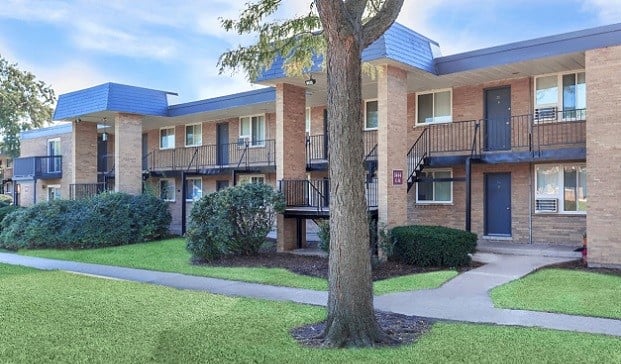
CHICAGO—Digitization, artificial intelligence, the Internet of Things (IoT) and robotic process automation (RPA) are turning the world of work on its head—and the workplace is changing right along with it.
The workforce is taking different shapes, too, with on-demand labor working alongside fulltime employees. And as Baby Boomers retire, the war for talent has pushed workplace strategy to the forefront. Instead of just cutting costs, companies need workplaces that attract and retain talent, and inspire high performance.
To achieve their ambitions, companies need a multi-faceted approach to workplace and corporate real estate, says John Forrest, Global & Americas CEO, Corporate Solutions, JLL. We sat down with Forrest to discuss JLL's new “Future of Work” model and outlook and what it means for corporate real estate.
GlobeSt.com: How can you help a workplace be more agile and better able to respond to unexpected changes?
Forrest: With real estate the third- or fourth-largest cost for many organizations, corporate real estate teams need a more holistic view of real estate, workplace and business strategies. Through conversations with our clients and our own experts, we developed our proprietary “The Future of Work” model and perspective to help companies pinpoint the areas they need to focus on to succeed in an era of uncertainty.
Our model provides a roadmap to help companies navigate the cultural and economic shifts, innovation and technology that are reshaping the concept of work. Specifically, we focus on five interdependent dimensions: human experience, digital drive, continuous innovation, operational excellence and financial management.
Rising to the challenge of the future of work involves many moving parts. By paying attention to all five dimensions of The Future of Work, organizations will be positioned to manage uncertainty and create opportunity.
GlobeSt.com: Should workplace strategy be a greater concern to C-level executives than it was several years ago. If so, why?
Forrest: Real estate should be about creating spaces for people to achieve their personal and professional ambitions and to help their organizations achieve theirs. That's why our model includes the “Human Experience” dimension. Organizations need to examine not only their offices as they are, but also how work and the workforce are evolving.
Creating the workplace of the future is not simply about constructing a new office. We expect offices in the future to offer high-tech, personalized tools and services, so the office stops being merely a major expense, but a tool in the war for talent.
Furthermore, today's new multi-generational workforce requires alternative work styles and new work environments. We envision innovative network-led spaces and technologies, in workplaces where people can interact and collaborate, not just with colleagues, but also with entrepreneurs and employees from other organizations.
You need to 'curate' the workplace as you set the social agenda to create networking opportunities and embrace collaboration. You need programs that prepare and manage not only the space, but also the work experience itself, to deliver ongoing efficiency, dynamism and wellness.

GlobeSt.com: The “Financial Performance” dimension references the “metrics that matter.” What are some metrics, beyond rent, that should be tracked? And how will doing so bring benefits?
The big question is, how do you move beyond cost savings to demonstrate where real estate is making an impact?
Metrics that matter are the ones that track desired performance outcomes and drive ROI measures. Real estate has the potential to contribute to an organization's goals and strategy. Participating in strategy discussions can lead to a more integrated and valuable CRE function.
Standard and traditional real estate metrics like lease expirations or cost-per-square-foot are inadequate for a complex real estate portfolio—and aren't necessarily meaningful to key stakeholders, anyway. And, where do you fit in new factors like using coworking spaces or smart building technology?
You need real estate metrics directly tied to business goals. Say your company wants to acquire companies to extend its product offerings. Your real estate measures would relate to quality of portfolio analysis and impact on acquisition decision making, for a start. You'd also track your speed-to-execute on facility rebranding, co-location or disposition of redundant assets.
GlobeSt.com: The Future of Work model refers to cross-departmental collaboration. Why do IT, HR and corporate real estate need to work more closely together?
Today, real estate, IT and HR can and should join forces to improve how people and resources effectively use space. That's why the “Operational Excellence” dimension of The Future of Work talks about collaboration among shared services. In the modern tech-enabled office, workplace is all about people, process and technology, and the place where they intersect. None of these issues can be tackled in a silo.
For example, if most of your staff works outside the office some or all the time, how can you accommodate people using their own devices? Bring-your-own-device (BYOD) policies drive down investment in laptops and other hardware, but you need to make sure everyone has the tools they need to be productive. Or, if people are using conference calls and videoconferencing more frequently, conference rooms could be reallocated to collaborative spaces or reconfigured to better meet people's needs. HR can provide insight into employee expectations and what a workplace needs to provide to keep them engaged and productive.
GlobeSt.com: Are all companies becoming, in some way, technology companies? How does that change how their corporate real estate practices?
Forrest: There's no doubt that even traditional face-to-face businesses—including ours—are becoming infused with technology at every level. Artificial intelligence, the Internet of Things, neuromorphic computing and other technologies are enabling companies to reinvent their business models and unlock new sources of growth.
CRE can't sit still while companies digitize their operations and transform their core businesses, which is the point of the “Digital Drive” dimension of the Future of Work. Workplace and real estate should help future-proof the larger business, not hold it back. Truly digital organizations adopt operating models that are adaptable and agile.
CRE can advance business transformation with interactive workplace technologies that help employees customize their workspaces and easily obtain services they need to be productive. CRE can also automate many aspects of facility management with workplace management systems, smart building technologies and other tools. Meanwhile, the data generated by all these computers can be aggregated and analyzed to improve workplace strategies along with building operating performance.
Finding creative ways to use technology could also fall under the “Continuous Innovation” dimension of The Future of Work. Technology isn't the only way to innovate, of course, but it is often involved. More than ever, companies today are focused on innovation, and that means constant changes in the types of work to be performed. CRE has to innovate, too.
We will see CRE teams exploring new technologies to enhance the workplace experience or streamline internal processes. In fact, we are already partnering with many of our clients to use new technologies to advance their goals, whether it's smart building systems, automated facility management or in workplace strategies. On our own account, we've been investing in promising technology companies, acquiring some and partnering with others, to bring CRE teams the best and most cost-effective tools to use in their organizations.

CHICAGO—Digitization, artificial intelligence, the Internet of Things (IoT) and robotic process automation (RPA) are turning the world of work on its head—and the workplace is changing right along with it.
The workforce is taking different shapes, too, with on-demand labor working alongside fulltime employees. And as Baby Boomers retire, the war for talent has pushed workplace strategy to the forefront. Instead of just cutting costs, companies need workplaces that attract and retain talent, and inspire high performance.
To achieve their ambitions, companies need a multi-faceted approach to workplace and corporate real estate, says John Forrest, Global & Americas CEO, Corporate Solutions, JLL. We sat down with Forrest to discuss JLL's new “Future of Work” model and outlook and what it means for corporate real estate.
GlobeSt.com: How can you help a workplace be more agile and better able to respond to unexpected changes?
Forrest: With real estate the third- or fourth-largest cost for many organizations, corporate real estate teams need a more holistic view of real estate, workplace and business strategies. Through conversations with our clients and our own experts, we developed our proprietary “The Future of Work” model and perspective to help companies pinpoint the areas they need to focus on to succeed in an era of uncertainty.
Our model provides a roadmap to help companies navigate the cultural and economic shifts, innovation and technology that are reshaping the concept of work. Specifically, we focus on five interdependent dimensions: human experience, digital drive, continuous innovation, operational excellence and financial management.
Rising to the challenge of the future of work involves many moving parts. By paying attention to all five dimensions of The Future of Work, organizations will be positioned to manage uncertainty and create opportunity.
GlobeSt.com: Should workplace strategy be a greater concern to C-level executives than it was several years ago. If so, why?
Forrest: Real estate should be about creating spaces for people to achieve their personal and professional ambitions and to help their organizations achieve theirs. That's why our model includes the “Human Experience” dimension. Organizations need to examine not only their offices as they are, but also how work and the workforce are evolving.
Creating the workplace of the future is not simply about constructing a new office. We expect offices in the future to offer high-tech, personalized tools and services, so the office stops being merely a major expense, but a tool in the war for talent.
Furthermore, today's new multi-generational workforce requires alternative work styles and new work environments. We envision innovative network-led spaces and technologies, in workplaces where people can interact and collaborate, not just with colleagues, but also with entrepreneurs and employees from other organizations.
You need to 'curate' the workplace as you set the social agenda to create networking opportunities and embrace collaboration. You need programs that prepare and manage not only the space, but also the work experience itself, to deliver ongoing efficiency, dynamism and wellness.

GlobeSt.com: The “Financial Performance” dimension references the “metrics that matter.” What are some metrics, beyond rent, that should be tracked? And how will doing so bring benefits?
The big question is, how do you move beyond cost savings to demonstrate where real estate is making an impact?
Metrics that matter are the ones that track desired performance outcomes and drive ROI measures. Real estate has the potential to contribute to an organization's goals and strategy. Participating in strategy discussions can lead to a more integrated and valuable CRE function.
Standard and traditional real estate metrics like lease expirations or cost-per-square-foot are inadequate for a complex real estate portfolio—and aren't necessarily meaningful to key stakeholders, anyway. And, where do you fit in new factors like using coworking spaces or smart building technology?
You need real estate metrics directly tied to business goals. Say your company wants to acquire companies to extend its product offerings. Your real estate measures would relate to quality of portfolio analysis and impact on acquisition decision making, for a start. You'd also track your speed-to-execute on facility rebranding, co-location or disposition of redundant assets.
GlobeSt.com: The Future of Work model refers to cross-departmental collaboration. Why do IT, HR and corporate real estate need to work more closely together?
Today, real estate, IT and HR can and should join forces to improve how people and resources effectively use space. That's why the “Operational Excellence” dimension of The Future of Work talks about collaboration among shared services. In the modern tech-enabled office, workplace is all about people, process and technology, and the place where they intersect. None of these issues can be tackled in a silo.
For example, if most of your staff works outside the office some or all the time, how can you accommodate people using their own devices? Bring-your-own-device (BYOD) policies drive down investment in laptops and other hardware, but you need to make sure everyone has the tools they need to be productive. Or, if people are using conference calls and videoconferencing more frequently, conference rooms could be reallocated to collaborative spaces or reconfigured to better meet people's needs. HR can provide insight into employee expectations and what a workplace needs to provide to keep them engaged and productive.
GlobeSt.com: Are all companies becoming, in some way, technology companies? How does that change how their corporate real estate practices?
Forrest: There's no doubt that even traditional face-to-face businesses—including ours—are becoming infused with technology at every level. Artificial intelligence, the Internet of Things, neuromorphic computing and other technologies are enabling companies to reinvent their business models and unlock new sources of growth.
CRE can't sit still while companies digitize their operations and transform their core businesses, which is the point of the “Digital Drive” dimension of the Future of Work. Workplace and real estate should help future-proof the larger business, not hold it back. Truly digital organizations adopt operating models that are adaptable and agile.
CRE can advance business transformation with interactive workplace technologies that help employees customize their workspaces and easily obtain services they need to be productive. CRE can also automate many aspects of facility management with workplace management systems, smart building technologies and other tools. Meanwhile, the data generated by all these computers can be aggregated and analyzed to improve workplace strategies along with building operating performance.
Finding creative ways to use technology could also fall under the “Continuous Innovation” dimension of The Future of Work. Technology isn't the only way to innovate, of course, but it is often involved. More than ever, companies today are focused on innovation, and that means constant changes in the types of work to be performed. CRE has to innovate, too.
We will see CRE teams exploring new technologies to enhance the workplace experience or streamline internal processes. In fact, we are already partnering with many of our clients to use new technologies to advance their goals, whether it's smart building systems, automated facility management or in workplace strategies. On our own account, we've been investing in promising technology companies, acquiring some and partnering with others, to bring CRE teams the best and most cost-effective tools to use in their organizations.
© Touchpoint Markets, All Rights Reserved. Request academic re-use from www.copyright.com. All other uses, submit a request to [email protected]. For more inforrmation visit Asset & Logo Licensing.








